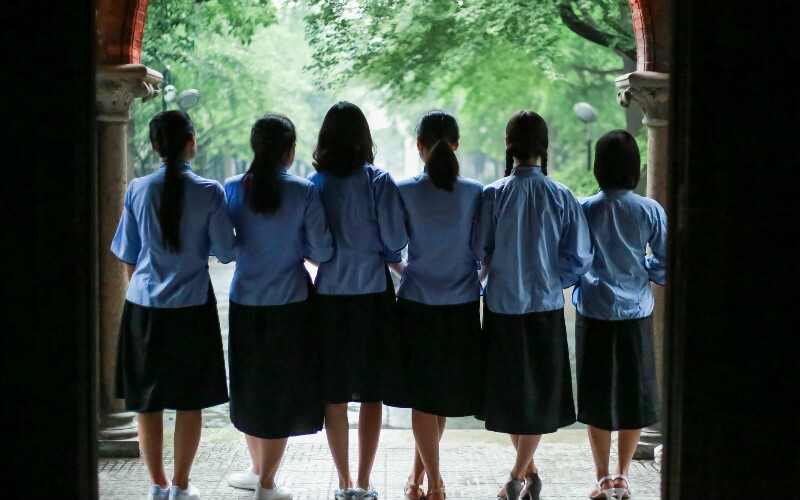 Sun Yat-sen's Statue in Guangzhou
Sun Yat-sen's Statue in GuangzhouThe Republic of China is usually referred to as the first democratic republic in China after the 1911 (Xinhai) Revolution. It lasted from 1912 to 1949 in Chinese mainland; basically the transition time between feudalism and modernization.
Quick Facts About the Republic of China
- Chinese Name: 中华民国 (/jong hwaa min gwor/)
- Founder: Sun Yat-sen
- Capital: Nanjing, Beijing, Chongqing (auxiliary capital)
- Governing party: Kuomintang (KMT)
- Currency: silver dollar, legal tender
Republic of China’s History
Sprouting Period - Xinhai Revolution
At the end of the 19th century, the last imperial dynasty - the Qing Dynasty - was becoming more and more corrupt and decadent. In addition, the aggression of western capitalist powers made more and more people realize the backwardness of China’s social system. Various revolutionary groups emerged and the Xinhai Revolution broke out.
The Xinhai Revolution was the nation-wide revolution from 1911 to 1912, overthrowing the feudal regime of the Qing dynasty (1636–1912).
The Wuchang Uprising marked the beginning of the 1911 Revolution. It was the first successful armed uprising against the Qing regime. After the Wuchang Uprising, lots of provinces proclaimed independence. Then, regional military governments agreed to set up a provisional national government in Nanjing.
Founding (1912.1–1912.4)
 The President Palace in Nanjing
The President Palace in NanjingIn January 1912, Sun Yat-sen was elected to the position of provisional president. After he took office, he announced the state’s name to be the Republic of China, a five-color flag to be the national flag, and the solar calendar to be the working calendar.
The provisional government also published a Provisional Constitution of the Republic of China.
In order to take over government control completely, the provisional government compromised with Yuan Shikai, a cabinet minister from the Qing dynasty, and leader of the Beiyang army.
In February 1912, Yuan Shikai persuaded Puyi (the last emperor of the Qing dynasty) to abdicate and in April, Sun Yat-sen resigned as provisional president. After that, Yuan Shikai was elected provisional president of the Republic of China and the Beiyang Warlord Period began.
Dark Ages - Beiyang Warlord Period
In April 1912, Yuan Shikai was elected provisional president and moved the capital from Nanjing to Beijing. The period from 1912 to 1928 is called the Beiyang Warlord Period.
At the beginning of this period, Yuan tried to restore the monarchy but was strongly resisted. After Yuan died in 1916, the Beiyang government existed in name only. Different warlords fought to extend their regional control.
Renaissance - Nanjing Decade
 The former site of Huangpu Military Academy
The former site of Huangpu Military AcademyAfter Yuan Shikai took over the provisional government, Sun Yat-sen moved to southern China. He still made intense efforts to push for democratic reform in China.
In 1924, Sun Yat-sen established the Sun Yat-sen University and Whampoa Military Academy in Guangzhou.
After Sun Yat-sen died in 1925, Chiang Kai-shek became leader of the KMT.
Beginning in 1926, Chiang led the Northern Expedition to conquer the northern warlords and unify China again. In 1927, the Nanjing KMT Government was formally established. It aimed to build a modern democratic society.
Along with the central government’s corruption and class contradictions, it lacked control of the whole country. Large areas of China remained under semi-autonomous rule.
There was continuous division and struggle between nationalists of the KMT and communists of the Communist Party of China (CPC). The Red Army even completed the Long March, to escape the KMT’s crackdown and reverse the tide.
Second World War 1937-1945

In 1931, Japan started to invade northern China. It set up a puppet state, Manchukuo (1932–1945), and made the ex-Qing emperor Puyi the figurehead leader. In addition, Japan tried to extend its occupied territory.
In 1937, a conflict occurred near Beijing between the Chinese and Japanese armies. This sparked the Sino-Japanese War.
To support the survival of the nation, the KMT and CPC agreed to join forces against the Japanese.
Post-Second World War
The Japanese finally surrendered in 1945, but the war and division between communists and nationalists in China became more and more fierce.
The second civil war began. In Chinese mainland today, it’s also called the War of Liberation. The first civil war between KMT and CPC was from 1927 to 1937.
In April 1949, after a series of battles, the KMT government in Nanjing was taken captive by the CPC Army and the KMT lost its last control center in Chinese mainland. Then Chiang Kai-shek led nationalist troops to flee to Taiwan.
On 7 December 1949, Chiang Kai-shek proclaimed Taipei to be the temporary capital of the Republic of China.
Republic of China’s Economic Development
The general trend of economic development in the Republic of China was up and down.
Against the background of political and economic turmoil, business, transportation, and financial industries sprung up rapidly. On the other hand, currency inflation and enterprise bankruptcy were rife throughout the Republic of China.
Rural Area Economy
In the rural areas, the self-subsistence of the farming economy prevailed.
Compared to the time of the Qing dynasty, people could procure better and more land, having the right to buy or sell. Due, however, to insufficient institutionalization of the land market and the chaos of war, the average farm size for each family was still very low. Tenant farming was still very common.
Business
Capitalism was instituted during the Republic of China. Lots of foreign funds flooded into China and stimulated the development of Chinese business.
Business, however, was never able to seize its golden opportunity, for war persistently intervened.
Transportation
 China's High Speed Train
China's High Speed TrainThanks to the boom in commerce, the need to transport freight stimulated development of transport generally.
As to railway construction, about 15,000 kilometers of railway were built during the Republic of China. But 1/3 of it was finished by Japan in northern China for the transport of goods and mining resources.
As for highway construction, there was basically none during the Qing dynasty (1636–1912). The KMT government finished constructing 116,000 kilometers of highway. Most of the highways were built after 1928, some to support the civil war effort.
Diplomacy of the Republic of China
The diplomacy of the Republic of China resulted in many proud achievements, but also some losses. Lots of brilliant diplomats were available to help the country.
The main gains on the diplomatic front during the Republic period included: 1) transfer and modernization of the Qing dynasty’s diplomatic office; 2) cultivation of generations of talented and professional diplomats; 3) establishment of diplomatic relations with 59 countries; 4) abandonment of unequal treaties and concessions in China, and retaking of independent tariff rights; 5) admission as one of the permanent members of the UN, until 1971.
This was the first time the Chinese nation protected its own rights and interests on the world stage.
The Republic of China received a great deal of support from the USA and the UK during World War Ⅱ. This speeded up the victory process in the Sino-Japanese War.









